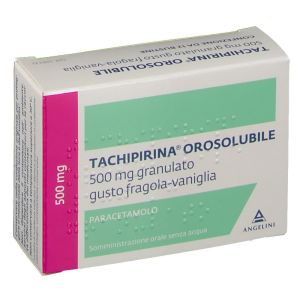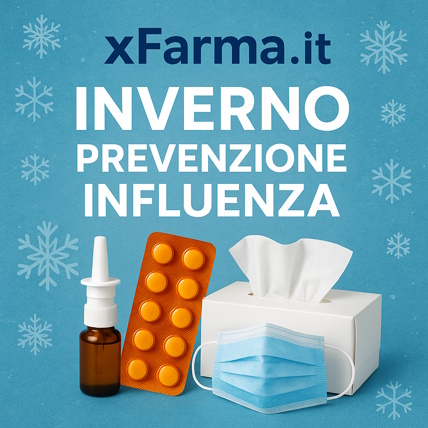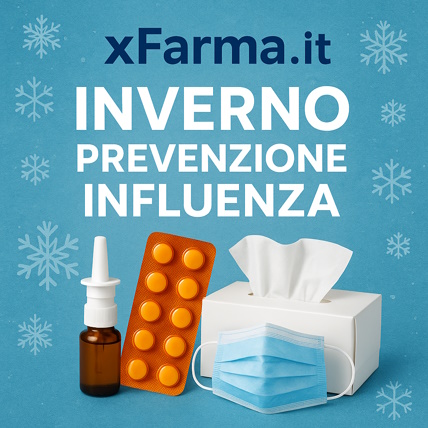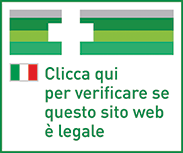Ship in Europe, Find out rates!
Language
Tachipirina Buccal 500mg Strawberry-Vanilla Flavor 12 Sachets

Regular Price
€8.50
Special Price
€7.85
-8%
Save: €0.65
In stock
Recent lowest price:
€7.50
- box Delivery in Italy in 24/48 and free returns
- star3.000+ positive reviews
- dropboxOver 60,000 products in the catalog
NAME
ORSOLUBLE TACHIPIRINA 500 MG GRANULATED STRAWBERRY-VANILLA FLAVOR
PHARMACOTHERAPEUTIC CATEGORY
Analgesics and antipyretics, anilides.
ACTIVE PRINCIPLES
One sachet contains 500 mg of paracetamol.
EXCIPIENTS
Sorbitol, talc, butyl methacrylate basic copolymer, light magnesium oxide, hypromellose, carmellose sodium, stearic acid, sodium lauryl sulfate, magnesium stearate (Ph.Eur.), Titanium dioxide (E 171), sucralose, simethicone, N, 2,3- trimethyl-2- (propan-2-yl) butanamide, strawberry flavor (contains maltodextrin, gum arabic (E414), natural and / or natural flavoring substances, propylene glycol (E1520), triacetin (E1518), maltol (E636 )), vanilla flavor (contains maltodextrin, natural flavoring substances and / or identical to natural ones, propylene glycol (E1520), sucrose).
INDICATIONS
Symptomatic treatment of mild to moderate pain and fever.
CONTRAINDICATIONS / SECONDARY EFFECT
Hypersensitivity to the active substance or to any of the excipients; severe kidney failure; alcohol abuse.
DOSAGE
Doses depend on body weight and age. A single dose ranges from 10 to 15 mg / kg of body weight up to a maximum of 60 to 75 mg / kg for the total daily dose. The time interval between individual doses depends on the symptoms and the maximum daily dose. In any case, it must not be less than 4 hours. It should not be used for more than three days without consulting your doctor. 500 mg sachets. 26-40kg (8-12 years): single dose: 500 mg paracetamol (1 sachet); maximum daily dose 1500 mg paracetamol (3 sachets). > 40 kg (children over 12 years and adults): single dose: 500-1000 mg paracetamol (1-2 sachets); maximum daily dose 3000 mg paracetamol (6 sachets of 500 mg). For oral use only. The granulate is taken by placing it directly on the tongue and must be swallowed without water. Do not take on a full stomach. Hepatic or renal insufficiency: In patients with hepatic or renal insufficiency or Gilbert's syndrome, the dose should be reduced or the time interval between administrations extended. Patients with renal insufficiency: in patients with severe renal insufficiency (creatinine clearance <10 ml / min.), A time interval between administrations of at least 8 hours is respected. Chronic alcoholism: Chronic alcohol consumption can lower the toxicity threshold of paracetamol. In these patients, the time interval between two doses should be at least 8 hours. The dose of 2 g of paracetamol per day should not be exceeded. Elderly patients: No dose adjustment is required in the elderly. Children and adolescents of reduced weight: paracetamol 500 mg sachets is not suitable for children under the age of 8 years and with a body weight of less than 26 kg. For this patient group, other formulations and strengths are available. For all indications. Adults, the elderly and children over 12 years of age: the usual dose is 500 - 1000 mg every 4 - 6 hours up to a maximum of 3 g per day. The dose should not be repeated for four hours. Renal insufficiency: the dose should be reduced in case of renal insufficiency. Glomerular filtration 10-50 ml / min: 500 mg every 6 hours; glomerular filtration <10 ml / nub; 500 mg every 8 hours. The effective daily dose should be considered, without exceeding 60 mg / kg / day (without exceeding 3 g / day), in the following situations: adults weighing less than 50 kg; hepatocellular insufficiency (mild to moderate); chronic alcoholism; dehydration; chronic malnutrition. Hepatic or renal insufficiency: In patients with hepatic or renal insufficiency or Gilbert's syndrome, the dose should be reduced or the dosing interval extended. The sachet formulation is not recommended for children under 4 years of age. Older children (4 - 12 years) can be given 250 - 500 mg every 4 - 6 hours up to a maximum of 4 doses over a 24 hour period.
STORAGE
Do not store above 30 degrees C. Store in the original package in order to protect from light and moisture.
WARNINGS
To avoid the risk of overdose, it is necessary to check that any other drugs taken concomitantly do not contain paracetamol. Paracetamol should be administered with caution to patients with mild to moderate hepatocellular insufficiency (including Gilbert's syndrome), severe hepatic insufficiency (Child-Pugh> 9), acute hepatitis, concomitant treatment with drugs that impair liver function, deficiency of glucose-6-phosphate dehydrogenase, haemolytic anemia, chronic alcohol abuse, severe renal insufficiency (creatinine clearance <10 ml / min). If you have a high fever or signs of secondary infection, or if symptoms persist for more than 3 days, you should see your doctor. In general, paracetamol-containing medicines can only be taken for a few days and at low doses without consulting your doctor or dentist. In case of incorrect and prolonged use of analgesics at high doses, headache episodes may occur which should not be treated with higher doses of the drug. In general, the habitual intake of analgesics, especially a combination of different analgesic substances, can lead to permanent renal damage with the risk of renal failure (analgesic nephropathy). Prolonged or frequent use is not recommended. Patients should be advised not to take other products containing paracetamol at the same time. Taking multiple daily doses in a single administration can severely damage the liver. In this case, the patient does not lose consciousness, but a doctor should be consulted immediately. Prolonged use without medical supervision can be harmful. In children treated with 60 mg / kg per day of paracetamol, the association with another antipyretic is not justified except in the case of ineffectiveness. Sudden interruption of the intake of analgesics after a prolonged period of incorrect use, at high doses, can cause headache, fatigue, muscle pain, nervousness and autonomic symptoms. These withdrawal symptoms resolve within a few days. Until then, further analgesics should be avoided and should not be resumed without consulting your doctor. Care should be taken when taking paracetamol in combination with inductors of cytochrome CYP3A4 or when using substances that induce liver enzymes such as rifampicin, cimetidine and antiepileptics such as glutethimide, phenobarbital and carbamazepine. Care should be taken when administering paracetamol to patients with renal insufficiency (creatinine clearance ≤ 30 ml / min). Alcohol consumption should be avoided during treatment with paracetamol. The risks of overdose are greater in patients with non-cirrhotic alcoholic liver disease. Care should be taken in case of chronic alcoholism. In patients with alcohol abuse the dose should be reduced. In this case, the daily dose should not exceed 2 grams. This medicine contains sorbitol and sucrose. In the presence of a high fever or signs of secondary infection or persistence of symptoms beyond 3 days, a re-evaluation of the treatment should be carried out. Doses higher than recommended involve the risk of very serious liver injury. Treatment with antidote should be given as soon as possible. Paracetamol should be used with caution in case of dehydration and chronic malnutrition.
INTERACTIONS
Intake of probenecid inhibits the binding of paracetamol to glucuronic acid, resulting in an approximately two-fold reduction in paracetamol clearance. In patients taking probenecid concomitantly, the dose of paracetamol should be reduced. The metabolism of paracetamol is increased in patients taking drugs that induce enzymes, such as rifampicin and some antiepileptics (carbamazepine, phenytoin, phenobarbital, primidone). Some isolated reports describe unexpected hepatotoxicity in patients taking enzyme-inducing medicinal products. Concomitant administration of paracetamol and AZT (zidovudine) increases the tendency to neutropenia. Therefore, co-administration of this drug together with AZT should only be done on the advice of the physician. Concomitant intake of drugs that accelerate gastric emptying, such as metoclopramide, accelerates the absorption and onset of action of paracetamol. The concomitant intake of drugs that slow gastric emptying can delay the absorption and the onset of the action of paracetamol. Cholestyramine reduces the absorption of paracetamol and, therefore, cannot be administered before one hour has elapsed from the administration of paracetamol. Repeated intake of paracetamol for periods longer than one week increases the effect of anticoagulants, in particular warfarin. Therefore, long-term administration of paracetamol in patients treated with anticoagulants should only take place under the supervision of the physician. Occasional paracetamol intake has no significant effect on bleeding tendency. Laboratory suitest effects: paracetamol can interfere with the determinations of uric acid using phosphotungstic acid and with those of blood glucose using the glucose-oxidase-peroxidase reaction. Probenecid causes an almost two-fold reduction in the clearance of paracetamol by inhibiting its conjugation with glucuronic acid. A reduction in paracetamol should be considered in case of concomitant treatment with probenecid. Paracetamol increases plasma levels of acetylsalicylic acid and chloramphenicol.
SIDE EFFECTS
Frequencies of adverse reactions: very common (> = 1/10), common (> = 1/100, <1/10), uncommon (> = 1 / 1,000, <1/100), rare (> = 1 / 10,000 , <1 / 1,000), very rare (<1 / 10,000). Disorders of the blood and lymphatic system. Rare: anemia, non-haemolytic anemias and bone marrow depression; thrombocytopenias. Vascular pathologies. Rare: edema. Gastrointestinal disorders. Rare: exocrine pancreatic conditions, acute and chronic pancreatitis, gastrointestinal haemorrhages, abdominal pain, diarrhea, nausea, vomiting, hepatobiliary disorders. Rare: hepatic failure, hepatic necrosis, jaundice. Disorders of the immune system. Rare: allergic conditions, anaphylactic reaction, allergies to foods, food additives, drugs and other chemicals. Skin and subcutaneous tissue disorders. Rare: hives, itching, rash, sweating, purpura, angioedema; very rare. Very rare cases of severe skin reactions have been reported. Renal and urinary disorders. Rare: nephropathies, nephropathies and tubular disorders. Very rare cases of severe skin reactions have been reported. Nephrotoxic effects are infrequent and have not been reported in association with therapeutic doses, except after prolonged administration. Report any suspected adverse reactions via the national reporting system.
PREGNANCY AND BREASTFEEDING
Epidemiological data from the use of oral therapeutic doses of paracetamol do not indicate any undesirable effects on pregnancy or on the health of the fetus or neonate. Prospective data on pregnancies exposed to overdose did not show an increased risk of malformation. Reproductive studies with oral administration did not show any malformation or foetotoxic effects. Consequently, in normal conditions of use, paracetamol can 'be used for the duration of pregnancy, after having performed an assessment of the risks and benefits. During pregnancy, paracetamol should not be taken for long periods, in high doses or in combination with other drugs as the safety of use in these cases is not established. After oral intake, paracetamol is excreted in breast milk in small quantities. No undesirable effects have been reported in breastfed infants. Therapeutic doses of this medicine can be used during breastfeeding.
ORSOLUBLE TACHIPIRINA 500 MG GRANULATED STRAWBERRY-VANILLA FLAVOR
PHARMACOTHERAPEUTIC CATEGORY
Analgesics and antipyretics, anilides.
ACTIVE PRINCIPLES
One sachet contains 500 mg of paracetamol.
EXCIPIENTS
Sorbitol, talc, butyl methacrylate basic copolymer, light magnesium oxide, hypromellose, carmellose sodium, stearic acid, sodium lauryl sulfate, magnesium stearate (Ph.Eur.), Titanium dioxide (E 171), sucralose, simethicone, N, 2,3- trimethyl-2- (propan-2-yl) butanamide, strawberry flavor (contains maltodextrin, gum arabic (E414), natural and / or natural flavoring substances, propylene glycol (E1520), triacetin (E1518), maltol (E636 )), vanilla flavor (contains maltodextrin, natural flavoring substances and / or identical to natural ones, propylene glycol (E1520), sucrose).
INDICATIONS
Symptomatic treatment of mild to moderate pain and fever.
CONTRAINDICATIONS / SECONDARY EFFECT
Hypersensitivity to the active substance or to any of the excipients; severe kidney failure; alcohol abuse.
DOSAGE
Doses depend on body weight and age. A single dose ranges from 10 to 15 mg / kg of body weight up to a maximum of 60 to 75 mg / kg for the total daily dose. The time interval between individual doses depends on the symptoms and the maximum daily dose. In any case, it must not be less than 4 hours. It should not be used for more than three days without consulting your doctor. 500 mg sachets. 26-40kg (8-12 years): single dose: 500 mg paracetamol (1 sachet); maximum daily dose 1500 mg paracetamol (3 sachets). > 40 kg (children over 12 years and adults): single dose: 500-1000 mg paracetamol (1-2 sachets); maximum daily dose 3000 mg paracetamol (6 sachets of 500 mg). For oral use only. The granulate is taken by placing it directly on the tongue and must be swallowed without water. Do not take on a full stomach. Hepatic or renal insufficiency: In patients with hepatic or renal insufficiency or Gilbert's syndrome, the dose should be reduced or the time interval between administrations extended. Patients with renal insufficiency: in patients with severe renal insufficiency (creatinine clearance <10 ml / min.), A time interval between administrations of at least 8 hours is respected. Chronic alcoholism: Chronic alcohol consumption can lower the toxicity threshold of paracetamol. In these patients, the time interval between two doses should be at least 8 hours. The dose of 2 g of paracetamol per day should not be exceeded. Elderly patients: No dose adjustment is required in the elderly. Children and adolescents of reduced weight: paracetamol 500 mg sachets is not suitable for children under the age of 8 years and with a body weight of less than 26 kg. For this patient group, other formulations and strengths are available. For all indications. Adults, the elderly and children over 12 years of age: the usual dose is 500 - 1000 mg every 4 - 6 hours up to a maximum of 3 g per day. The dose should not be repeated for four hours. Renal insufficiency: the dose should be reduced in case of renal insufficiency. Glomerular filtration 10-50 ml / min: 500 mg every 6 hours; glomerular filtration <10 ml / nub; 500 mg every 8 hours. The effective daily dose should be considered, without exceeding 60 mg / kg / day (without exceeding 3 g / day), in the following situations: adults weighing less than 50 kg; hepatocellular insufficiency (mild to moderate); chronic alcoholism; dehydration; chronic malnutrition. Hepatic or renal insufficiency: In patients with hepatic or renal insufficiency or Gilbert's syndrome, the dose should be reduced or the dosing interval extended. The sachet formulation is not recommended for children under 4 years of age. Older children (4 - 12 years) can be given 250 - 500 mg every 4 - 6 hours up to a maximum of 4 doses over a 24 hour period.
STORAGE
Do not store above 30 degrees C. Store in the original package in order to protect from light and moisture.
WARNINGS
To avoid the risk of overdose, it is necessary to check that any other drugs taken concomitantly do not contain paracetamol. Paracetamol should be administered with caution to patients with mild to moderate hepatocellular insufficiency (including Gilbert's syndrome), severe hepatic insufficiency (Child-Pugh> 9), acute hepatitis, concomitant treatment with drugs that impair liver function, deficiency of glucose-6-phosphate dehydrogenase, haemolytic anemia, chronic alcohol abuse, severe renal insufficiency (creatinine clearance <10 ml / min). If you have a high fever or signs of secondary infection, or if symptoms persist for more than 3 days, you should see your doctor. In general, paracetamol-containing medicines can only be taken for a few days and at low doses without consulting your doctor or dentist. In case of incorrect and prolonged use of analgesics at high doses, headache episodes may occur which should not be treated with higher doses of the drug. In general, the habitual intake of analgesics, especially a combination of different analgesic substances, can lead to permanent renal damage with the risk of renal failure (analgesic nephropathy). Prolonged or frequent use is not recommended. Patients should be advised not to take other products containing paracetamol at the same time. Taking multiple daily doses in a single administration can severely damage the liver. In this case, the patient does not lose consciousness, but a doctor should be consulted immediately. Prolonged use without medical supervision can be harmful. In children treated with 60 mg / kg per day of paracetamol, the association with another antipyretic is not justified except in the case of ineffectiveness. Sudden interruption of the intake of analgesics after a prolonged period of incorrect use, at high doses, can cause headache, fatigue, muscle pain, nervousness and autonomic symptoms. These withdrawal symptoms resolve within a few days. Until then, further analgesics should be avoided and should not be resumed without consulting your doctor. Care should be taken when taking paracetamol in combination with inductors of cytochrome CYP3A4 or when using substances that induce liver enzymes such as rifampicin, cimetidine and antiepileptics such as glutethimide, phenobarbital and carbamazepine. Care should be taken when administering paracetamol to patients with renal insufficiency (creatinine clearance ≤ 30 ml / min). Alcohol consumption should be avoided during treatment with paracetamol. The risks of overdose are greater in patients with non-cirrhotic alcoholic liver disease. Care should be taken in case of chronic alcoholism. In patients with alcohol abuse the dose should be reduced. In this case, the daily dose should not exceed 2 grams. This medicine contains sorbitol and sucrose. In the presence of a high fever or signs of secondary infection or persistence of symptoms beyond 3 days, a re-evaluation of the treatment should be carried out. Doses higher than recommended involve the risk of very serious liver injury. Treatment with antidote should be given as soon as possible. Paracetamol should be used with caution in case of dehydration and chronic malnutrition.
INTERACTIONS
Intake of probenecid inhibits the binding of paracetamol to glucuronic acid, resulting in an approximately two-fold reduction in paracetamol clearance. In patients taking probenecid concomitantly, the dose of paracetamol should be reduced. The metabolism of paracetamol is increased in patients taking drugs that induce enzymes, such as rifampicin and some antiepileptics (carbamazepine, phenytoin, phenobarbital, primidone). Some isolated reports describe unexpected hepatotoxicity in patients taking enzyme-inducing medicinal products. Concomitant administration of paracetamol and AZT (zidovudine) increases the tendency to neutropenia. Therefore, co-administration of this drug together with AZT should only be done on the advice of the physician. Concomitant intake of drugs that accelerate gastric emptying, such as metoclopramide, accelerates the absorption and onset of action of paracetamol. The concomitant intake of drugs that slow gastric emptying can delay the absorption and the onset of the action of paracetamol. Cholestyramine reduces the absorption of paracetamol and, therefore, cannot be administered before one hour has elapsed from the administration of paracetamol. Repeated intake of paracetamol for periods longer than one week increases the effect of anticoagulants, in particular warfarin. Therefore, long-term administration of paracetamol in patients treated with anticoagulants should only take place under the supervision of the physician. Occasional paracetamol intake has no significant effect on bleeding tendency. Laboratory suitest effects: paracetamol can interfere with the determinations of uric acid using phosphotungstic acid and with those of blood glucose using the glucose-oxidase-peroxidase reaction. Probenecid causes an almost two-fold reduction in the clearance of paracetamol by inhibiting its conjugation with glucuronic acid. A reduction in paracetamol should be considered in case of concomitant treatment with probenecid. Paracetamol increases plasma levels of acetylsalicylic acid and chloramphenicol.
SIDE EFFECTS
Frequencies of adverse reactions: very common (> = 1/10), common (> = 1/100, <1/10), uncommon (> = 1 / 1,000, <1/100), rare (> = 1 / 10,000 , <1 / 1,000), very rare (<1 / 10,000). Disorders of the blood and lymphatic system. Rare: anemia, non-haemolytic anemias and bone marrow depression; thrombocytopenias. Vascular pathologies. Rare: edema. Gastrointestinal disorders. Rare: exocrine pancreatic conditions, acute and chronic pancreatitis, gastrointestinal haemorrhages, abdominal pain, diarrhea, nausea, vomiting, hepatobiliary disorders. Rare: hepatic failure, hepatic necrosis, jaundice. Disorders of the immune system. Rare: allergic conditions, anaphylactic reaction, allergies to foods, food additives, drugs and other chemicals. Skin and subcutaneous tissue disorders. Rare: hives, itching, rash, sweating, purpura, angioedema; very rare. Very rare cases of severe skin reactions have been reported. Renal and urinary disorders. Rare: nephropathies, nephropathies and tubular disorders. Very rare cases of severe skin reactions have been reported. Nephrotoxic effects are infrequent and have not been reported in association with therapeutic doses, except after prolonged administration. Report any suspected adverse reactions via the national reporting system.
PREGNANCY AND BREASTFEEDING
Epidemiological data from the use of oral therapeutic doses of paracetamol do not indicate any undesirable effects on pregnancy or on the health of the fetus or neonate. Prospective data on pregnancies exposed to overdose did not show an increased risk of malformation. Reproductive studies with oral administration did not show any malformation or foetotoxic effects. Consequently, in normal conditions of use, paracetamol can 'be used for the duration of pregnancy, after having performed an assessment of the risks and benefits. During pregnancy, paracetamol should not be taken for long periods, in high doses or in combination with other drugs as the safety of use in these cases is not established. After oral intake, paracetamol is excreted in breast milk in small quantities. No undesirable effects have been reported in breastfed infants. Therapeutic doses of this medicine can be used during breastfeeding.
| Destination | Cost | Detail |
|---|---|---|
| Italy | €5,90* | 24/72H |
| Austria, France, Germany, Slovenia | € 13* | 3 days |
| Belgium, Luxembourg, Portugal, Netherlands, Spain | € 14* | 4 days |
| Bulgary, Cechia, Hungary, Poland, Romania, Slovakia | € 19* | 5 days |
| Denmark, Estonia, Finland, Ireland, Lithuania, Latvia ,Sweden | € 22* | 5 days |
| United Kingdom, Switzerland, Greece, Malta/td> | € 30* | 7 days |
| Canada | € 40 | 7 Days |
European shipments with express courier: FedEx, MBE, DHL
*For the shipment outside band B ther's an extra cost of 22€ *For the shipment outside band C ther's an extra cost of 30€ Delivery Times exclude Saturday and Holidays
For Islands and Areas of difficult Accessibility the shipments are made in 72 hours and the cost will be increased by 15€
The images of the products shown on our site are purely indicative and may differ in shape, color, text and packaging shown on them. Given the difficulty of updating all the products on our site in real time or any errors, XFarma.it, all products will be identified through SKU MINSAN (code of the Ministry of Health).


